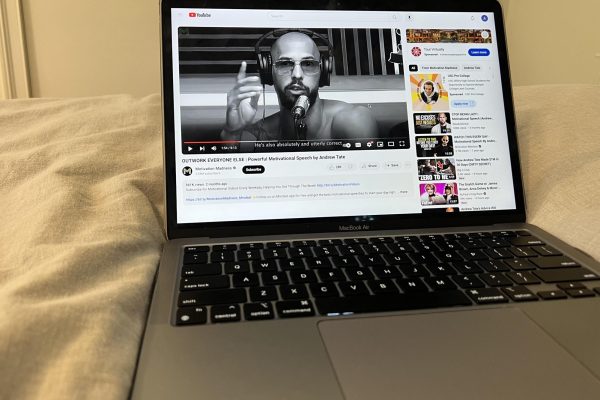Column: Anti-blackness in the Latinx community
Photo credit: Leslie Castaneda
An artistic illustration by senior Leslie Castaneda depicts some of the many different skin tones that are present in the Latinx community. This column covers anti-blackness in the Latinx community, specifically after the controversy surrounding this year’s Pepsi Super Bowl Halftime Show featuring JLo and Shakira.
March 17, 2020
When I first watched the Pepsi Super Bowl LIV Halftime Show, I was in awe. Tears welled up in my eyes as I watched Shakira and JLo fiercely sing and dance to songs I jammed out to as a kid. I couldn’t believe they were on the Super Bowl stage being watched by millions of people. Later that evening, I was scrolling through social media when I saw a few of my followers reposting multimedia content creator Rúben Angel’s (Queer Xicano Chisme’s) YouTube video, “This Is Why I’m Not Excited About the Latinx Representation at Super Bowl 2020.”
In the video, Angel spoke about the problematic aspects of the halftime show, especially post-Colin Kaepernick. Kaepernick was the San Francisco 49ers’ quarterback in the 2016 National Football League season and began to kneel during the national anthem as a form of protest against police brutality and racial injustice in the United States.
After the season, Kaepernick opted out of his contract, and to this day has not been picked up by any other NFL team. In addition, this year, Kaepernick and his former teammate Eric Reid received a settlement from the NFL for a grievance they filed accusing the league of blackball or preventing them from being hired by teams. The NFL indirectly admitted to ending Kaepernick’s football career because of his choice to protest.
In the past few years, many artists have refused to associate themselves with the NFL in solidarity with not only Kaepernick but the black community as well. These artists include Rihanna and Cardi B, both of who have rejected offers to perform at the Super Bowl halftime show.
In his video, Angel spoke about the NFL’s agenda behind having Shakira and JLo perform this year. He said that the NFL intended to essentially clean up their image by supporting people of color and framing the show as a “grander social justice issue.” This year, the NFL not only offered the stage to two female Latinx superstars, but they also had Los Tigres Del Norte open up the Super Bowl broadcast. They also had a Latina head chef at the Hard Rock Stadium in Miami Gardens — the stadium that hosted the game — for the first time. Regardless, Angel said that by Shakira and JLo accepting the offer, it felt like “us non-black Latinxs accepting an apology for something that didn’t happen to us.”
I watched his entire video and then began to read articles on other sites. At the time, I was conflicted. I felt like the show was a step in the right direction and gave Latinx people more representation, but at the same time, I could see what people were saying. The NFL has a questionable past and yes, they chose to feature the Latinx community, but they chose to do it with light-skinned, easily digestible Latinas.
If it weren’t for social media, I don’t think I would have questioned the performance; I might have just continued to praise it without thinking. I think this says a lot about how engraved anti-blackness is in our communities, including the Latinx community.
Latinx is a term used to refer to people of Latin American descent; it is an ethnicity. It is easy to lump all Latinx people into one group, but many fail to consider that Latin America is made up of 20 countries, meaning that Latinx people come from all different types of cultures and can look very different. More specifically, there is a vast variety of skin colors represented in Latinx people, but they definitely are not all treated the same.
Blatant anti-blackness in the Latinx community can be dated back centuries to blanqueamiento and branqueamento in Latin American countries. These terms quite literally translate to “whitening.” Blanqueamiento and branqueamento were practices used in many postcolonial countries to “mejorar la raza” or “whiten the race.” They were government-led social, political and economical efforts to make their populations whiter: for example, making it easier for white people to migrate to their country or violently reducing the amount of darker-skinned people in their country.
Archibald R. Murray Professor of Law Tanya Katerí Hernández further explains this obsession with whiteness, saying that Latin America has a long legacy with enforced slavery and many countries had a social hierarchy that was a racial caste system.
There are also many smaller-scale examples of anti-blackness in Latinx culture. For example, growing up, I loved eating “Negritos,” a chocolate Mexican snack distributed by the international brand Bimbo. The snack was created in 1957 and since then, the brand had advertised it with deeply problematic commercials that included blackface and stereotyping. “Negrito” is obviously an offensive outdated term, but the brand did not change the snack’s name until 2013 when it was rebranded as “Nito.”
It was partially because of my age, but I did not question the snack’s branding, or, for that matter, other smaller forms of anti-blackness around me. As a light-skinned Latina, I recognize that I have had the privilege of not needing to think about the inclusion of black Latinx people. I did not have to make a conscious effort to make space for them. Anti-blackness is a topic that was introduced to me in high school, and I think I began to be more aware of it as I met more people. When I was younger, I had not been in an environment with diverse Latinx people.
I know that deconstructing and unlearning anti-blackness will be a hard task. Even as a person of color, as a Latina, I do not understand the struggles of all the people who fall under that category. I do not understand all the prejudice that happens even within my own community. That is why I want to be more aware of who I am supporting and who I am putting down with my actions. I want to make a conscious effort to be inclusive in my definition of Latinidad to stand in solidarity with the black community.





![Freshman Milan Earl and sophomore Lucy Kaplan sit with their grandparents at Archer’s annual Grandparents and Special Friends Day Friday, March 15. The event took place over three 75-minute sessions. “[I hope my grandparents] gain an understanding about what I do, Kaplan said, because I know they ask a lot of questions and can sort of see what I do in school and what the experience is like to be here.](https://archeroracle.org/wp-content/uploads/2024/03/grandparents-day-option-2-1200x800.jpg)





























































